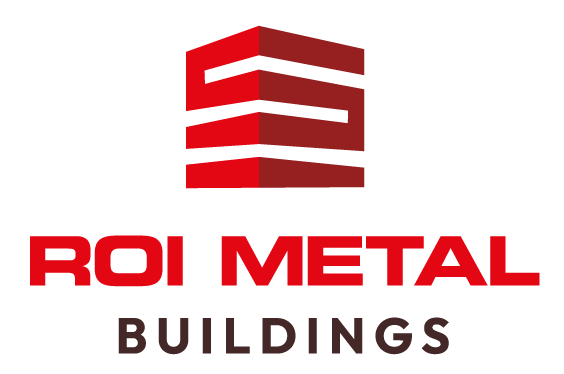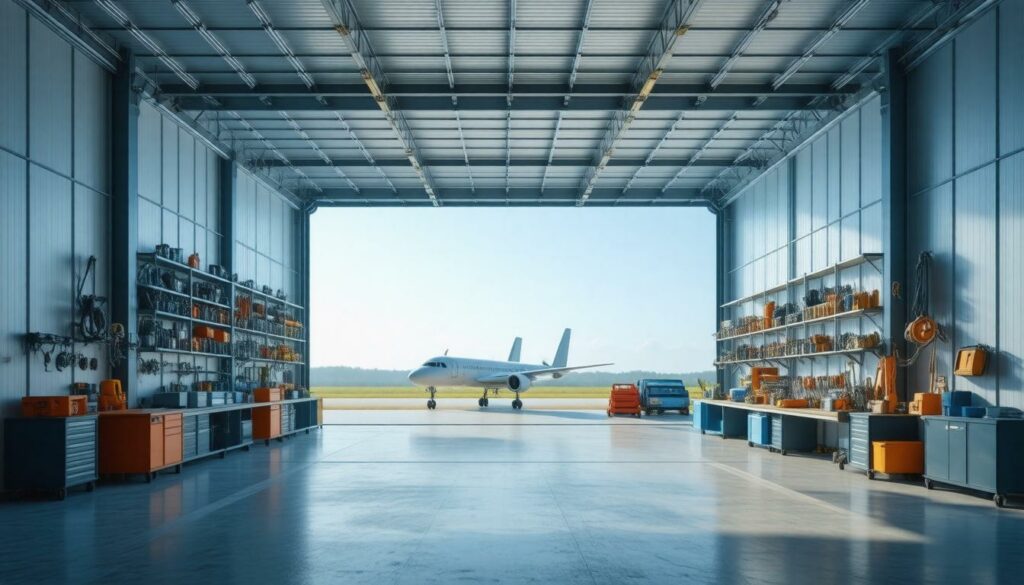Many owners might think that once their metal hangar has been built, the job is done. However, maintaining these structures is just as important as their initial construction. Regular upkeep not only extends the lifespan of your hangar but also helps extend the life of the entire structure by preventing premature deterioration. It also helps protect your valuable assets stored inside. From weatherproofing techniques to simple cleaning routines, there are practical steps you can take to keep your hangar in top shape. I’ve spent considerable time digging into the best practices for maintaining metal hangars, and I’m excited to share tips that can make a real difference in preserving your investment for years to come. Let’s dive into the essentials of effective maintenance!
Effective maintenance tips for metal hangars include regularly cleaning the exterior and interior to prevent dirt buildup, promptly removing snow from the roof to avoid structural damage, and routinely checking insulation for damage or moisture. Additionally, it’s important to keep gutters and drains clear of clogs, oil door hinges to prevent rusting, and conduct regular inspections for any signs of wear or needed repairs. The benefit of following these practices is improved safety, greater efficiency, and better protection of your assets.
Introduction to Hangar Maintenance
In the fast-paced world of aviation, hangar maintenance stands as a cornerstone of safety, efficiency, and operational success. Whether you’re managing a bustling commercial facility or a private aircraft hangar, maintaining your space is crucial for protecting valuable aircraft assets and ensuring the smooth execution of maintenance tasks. A well-kept hangar provides a controlled environment that minimizes wear on both equipment and clothes, reduces the risk of accidents, and supports the longevity of your entire operation.
Metal hangars, favored throughout the aviation industry for their durability and strength, require regular attention to prevent issues like rust and corrosion. Routine inspections and cleaning of the hangar floor, along with proper storage and organization of tools and equipment, are essential steps in maintaining a safe and efficient workspace. These maintenance tasks not only help prevent damage to aircraft and ground equipment but also contribute to the overall safety standards of your facility.
The importance of hangar maintenance extends beyond the building itself—it directly impacts the airworthiness of aircraft and the reliability of maintenance facilities. By providing suitable storage solutions and ensuring that all systems are up to date, you’re investing in the long-term value and performance of your aviation assets. Engaging with experienced technicians and utilizing the latest technology can further assist in optimizing your maintenance routines, extending the life of both your hangar and the aircraft it protects.
Ultimately, prioritizing hangar maintenance is about more than just meeting industry standards; it’s about providing a safe, efficient, and reliable environment that supports every aspect of your aviation journey.
Regular Maintenance Routine for Metal Hangars
To begin with, conducting basic inspections every six months should be a top priority. This time frame allows you to discover any visible signs of wear or damage, such as gaps, dents, or loose panels—this way, any potential issues can be addressed before becoming serious problems. When I perform these inspections, I like to think of myself as a detective; my job is to scan for details that may not seem significant at first but could escalate if left unchecked. These inspections and other maintenance activities are essential for effective hangar upkeep and ensuring ongoing safety and reliability.
Alongside the inspections, it’s crucial to regularly clean both the interior and exterior of the hangar. A thorough power washing of the exterior doesn’t merely make it look fresh; it helps remove dirt and debris that can trap moisture against the metal surface, which can eventually lead to rust. It’s fascinating how something as simple as keeping the surfaces clean contributes significantly to extending your hangar’s lifespan.
As you embark on this cleaning journey, take the time to inspect gutters and drains for clogs. Accumulated debris can cause water to pool around your hangar’s foundation, creating a prime environment for rust and corrosion. Don’t forget to clear any gutters and downspouts every three months; this proactive step plays an essential role in maintaining structural integrity.
Paying attention to minor issues is also critical. Whenever you notice small problems during your inspections or cleanings, be sure to address them immediately by repairing these issues as soon as possible. Ignoring small repairs can snowball into expensive issues later on, such as structural damage or compromised insulation that could affect temperature control inside.
Ensuring the hangar’s longevity also involves periodic checks for rust. A quick inspection allows you to identify any early signs of corrosion, allowing for timely interventions, such as applying a rust-inhibiting primer and paint every five years. Regularly treating rust helps avoid more significant damages that could require extensive repairs down the line.
By following these regular maintenance routines, you help optimize the performance and longevity of your metal hangar.
Practical Maintenance Tips
In addition to these monthly checks, consider stocking up on essential items that can facilitate ongoing maintenance. Keeping items like oil for hinges can prevent them from seizing up due to rust, while having basic tools means you’ll be well-equipped for quick fixes as they arise. Having a case of orange cleaner is also useful for tackling tougher stains and ensuring that your hangar presents itself well when visitors arrive.
Building strong maintenance habits not only enhances your hangar’s performance but also prepares you for more targeted tasks like addressing surface cleanliness. Let’s now explore effective strategies for keeping both the interior and exterior looking their best.
Cleaning Exterior and Interior Surfaces
Keeping the surfaces of your metal hangar clean is not merely about aesthetics; it’s a step towards preserving the structural integrity of the building.
When you start with cleaning the exterior, think of it as giving your hangar a thorough bath. Using a gentle power washer to remove loose dirt and dust is a wise first move. Aim for a pressure setting between 1500 and 2000 PSI—this level is effective without risking damage to the protective coating.
Once you’ve washed away the surface grime, if stubborn stains persist, consider mixing a mild detergent with water in a ratio of 1:10. This combination can tackle most tough spots without compromising your hangar’s finish.
Tip: Harsh chemicals are off-limits! They may strip away protective coatings or lead to corrosion, costing you more in repairs down the line.
Moving on to cleaning the interior, you’ll want to adopt a regular cleaning routine that keeps your space functional and inviting. A clean hangar not only looks nice but also improves organization and efficiency. Start by sweeping the floors to remove debris that can accumulate over time. Dust off surfaces to keep them free from grime. A tidy space also makes it much easier to search for tools, parts, or any dropped items, saving time and reducing frustration.
For more challenging grease or oil stains, reach for an effective degreaser designed specifically for metal surfaces—it’s key to maintaining both cleanliness and safety. A product like Simple Green provides industrial-strength cleaning while being safe for metal applications, helping maintain surfaces intact without damaging their finish.
Regular Upkeep
Regularly scheduled cleaning—ideally every six months—ensures that you catch any lingering issues before they escalate into bigger problems. Proper upkeep of a maintenance hangar is essential for operational efficiency, as it supports safe and effective aircraft servicing, repair, and maintenance. Incorporating power washing along with mild detergents into your maintenance routine will save you considerable effort down the line. Each time you perform these cleanings, take note of any wear and tear that might require further attention.
After cleaning, don’t forget to inspect for rust and corrosion—immediate action can make all the difference in extending the life of your metal hangar. Let’s consider effective strategies to identify and address such issues before they become serious concerns.
Inspection Tips for Rust and Corrosion
When it comes to maintaining metal hangars, understanding that rust and corrosion are persistent threats is crucial. Regular inspections can help catch these issues before they escalate into significant problems.
Inspecting your hangar shouldn’t feel like an overwhelming task; rather, think of it as a preventive measure you can easily incorporate into your routine. I find that conducting visual inspections at least every six months not only helps maintain the integrity of the structure but also fosters peace of mind as I know that everything is in good condition.
During inspections, be on the lookout for common rust indicators. The criteria for these inspections include checking for signs such as discoloration, flaking paint around joints and seams, bubbling surfaces, and any visible structural damage or corrosion. These criteria help ensure that you are systematically assessing the condition of the hangar and identifying potential issues early. Look for signs like discoloration or flaking paint around joints and seams because these can often signal underlying corrosion. Bubbling surfaces may also indicate that moisture has infiltrated the protective coating, allowing rust to develop underneath.
Monitoring moisture levels within and outside your hangar is essential too. If humidity levels consistently exceed 60%, this can create an ideal environment for rust formation. Consider investing in a hygrometer to keep track of those levels effectively. It’s a small tool that can make a massive difference in how well you’re able to manage moisture-related deterioration over time.
Addressing Rust
If you do find rust during your inspection, address it promptly. The first step is to remove any loose rust using a wire brush, ensuring that you tackle areas that show signs of wear carefully. Once the surface is clean, applying a high-quality rust-inhibiting primer will keep the issue from spreading and provide an excellent base for any paint you choose to apply next. After priming, repairing any damaged areas is essential to restore the structural integrity of the metal.
Remember, catching the issue when it’s still minor is key; if you’ve allowed it to become extensive, seek out professionals who specialize in metal restoration services.
As an added layer of protection, consider reapplying protective coatings every three to five years and be aware that temperature fluctuations can cause chemical reactions in protective layers leading to cracks and peeling. Keeping an eye on these changes will enhance the effectiveness of your preventative measures. Regular servicing of metal surfaces also helps prevent future rust and corrosion.
Implementing these straightforward procedures sets the stage for further safeguarding techniques that can significantly reduce wear over time.
Protective Measures Against Wear and Tear
Metal hangars may be robust structures, but they’re not invulnerable to the rigors of time and use. One of the most straightforward proactive steps you can take is to apply a protective sealant to the metal surfaces on an annual basis. This simple addition acts as a barrier against harsh elements, including UV rays that can lead to fading, as well as moisture that can cause rust over time. Regularly applying products like Rust-Oleum — which many professionals swear by — ensures your hangar remains resilient and looking pristine through all seasons.
In addition to using sealants, keeping a watchful eye on your hangar’s insulation can yield significant benefits. Insulation helps regulate temperature fluctuations, which can be harsh environments for metal surfaces. Extreme hot or cold temperatures may result in expansion and contraction of materials that could lead to structural integrity issues down the line. Thus, incorporating climate-specific insulation is an effective way to mitigate wear caused by these natural variances. The design of your insulation system plays a crucial role in providing comprehensive protection for the hangar, ensuring both energy efficiency and structural durability.
It’s fascinating how even small adjustments can have such a major impact on preserving your hangar’s condition over time.
Another area worth focusing on is the hardware. Regular maintenance of components such as hinges, locks, and rollers – all of which are vital for smooth operation – is crucial in lengthening their lifespan. The purpose of regular maintenance is to ensure that all moving parts function smoothly and to maximize their longevity. Ensuring that you oil door hinges a few times each year not only prevents rust but also keeps everything operating smoothly. A well-maintained hinge will help your doors close better while affording you peace of mind, knowing they won’t suddenly jam when you need quick access to your hangar space.
Additionally, staying up-to-date with paint touch-ups as soon as scratches appear is essential as well. Protective coatings are your first defense against oxidation and wear; thus, addressing any signs of deterioration immediately prevents larger problems from emerging later. It’s not just about aesthetics; it’s about maintaining the fundamental integrity of your hangar’s structure.
Implementing these protective measures may seem minimal at first glance, but consistent attention to detail creates a substantial difference in longevity and performance over time. Next, let’s shift our focus towards the importance of maintaining the moving parts that ensure efficient operation within your hangar environment.
Lubricating Hardware and Bolts
Regularly lubricating hardware may seem like a minor task, but it is crucial for ensuring your metal hangar operates smoothly and maintains structural integrity. Think of it as a routine oil change for your vehicle; neglecting it can lead to costly repairs down the road.
Every six months, ideally during the changing of seasons, it’s important to take a proactive approach by applying a high-quality lubricant to door hinges, bolts, and any moving parts within your hangar. Not only does this practice enhance functionality, but it also prolongs the lifespan of components that bear the brunt of wear and tear.
Silicone-based lubricants are especially recommended because they do not attract dust or debris like traditional oils tend to do. Products like WD-40’s Specialist Silicone Lubricant are specifically designed for metal surfaces and provide long-lasting lubrication that helps reduce friction. While using these lubricants, ensure you are following the ideal application temperature guidelines which range between 50°F and 85°F (10°C to 29°C); this ensures optimal performance and effectiveness.
While lubricating your hardware and bolts, it’s also essential to be attentive to any loose components.
A vital step during every lubrication session is checking for loose bolts. However, it’s often overlooked yet can prevent bigger headaches later on. Tightening even one unfastened bolt can avert structural issues that could compromise your hangar’s stability. Imagine how much easier it is to tighten a few screws now rather than dealing with an entire section of the structure needing repair after prolonged neglect. Little efforts go a long way in preserving the strength of your building.
Establish a maintenance checklist that includes inspecting each significant hardware component along with regular tasks you’d complete during lubrication sessions. Be sure to record the installation dates of hardware components to track their maintenance history and ensure timely servicing. This can help you keep track of when each part was last checked or serviced, ensuring nothing falls through the cracks.
If you’re managing multiple hangars or facilities, consider putting together:
- Hardware Inspection Schedule: Record when each component was last lubricated.
- Lubricant Inventory: Keep track of levels of oil, silicone spray, and penetrating oil so you never run short during essential maintenance.
- Maintenance Log: Document any repairs made after tightening bolts or adjusting hardware for future reference.
Lastly, let’s not forget about keeping the hangar visually appealing while maintaining its protective qualities against elements.
Advanced attention to detail in both functionality and appearance ensures that your hangar remains a valuable asset over time. Preventative maintenance doesn’t just preserve usability; it keeps everything looking fresh and professional too.
The next step will further enhance the aesthetics and protection of your hangar as we explore effective techniques for ensuring its surface remains in top condition.
Choosing and Applying the Right Paint
When it comes to preserving your metal hangar, repainting is far more than just a cosmetic touch-up; it’s about creating a barrier that protects your investment from rust and environmental degradation. Clear and durable marking on hangar floors is also essential for safety and operational efficiency, as it helps delineate hazard zones, boundaries, and safe pathways for both workers and aircraft.
Experts recommend choosing paints designed specifically for metal surfaces because they often incorporate rust-inhibiting properties critical for maintaining durability.
Look for products like those offered by Sherwin-Williams, which supply high-quality options formulated to withstand harsh weather conditions. These choices not only enhance the hangar’s appearance but also contribute significantly to its longevity. Remember, investing time and resources upfront can save you from costly repairs down the line.
Surface Preparation
The key to a successful paint job lies in preparation. Before you even think about painting, inspect the surface thoroughly. It’s vital that the metal is clean, free from dirt or loose rust particles that could compromise adhesion. If you encounter any rusty patches, they must be treated beforehand with a reliable rust inhibitor. This step is non-negotiable as it lays the groundwork for a smooth and lasting finish. Make sure all preparation steps meet industry standards for durability and adhesion.
For instance, products like Rust-Oleum Metal Primer are specially formulated to create an effective barrier against rust when applied to properly prepared surfaces. By using such primers, you’re ensuring that your topcoat has the best chance for longevity.
Application
Once the surface is prepped and primed, it’s time to apply your chosen paint. Use application methods such as a sprayer or roller—both techniques allow for even distribution across the surface. However, be aware of the limitations of each method and paint type; for example, sprayers may not be suitable for small or enclosed areas, while some paints may not adhere well in high-humidity environments. Consider these limitations when choosing the best option for your hangar. The goal here is to apply thin layers of paint rather than thick ones; this promotes faster drying times and helps avoid drips or uneven textures.
Allow each coat adequate time to dry thoroughly before moving on to the next one; this patience will pay off with a much smoother finish in the end. Typically, multiple light coats yield better results than fewer heavy applications, creating a more robust layer of protection against both moisture and UV rays.
While safeguarding your hangar through proper painting techniques is essential for long-term durability, understanding how to tackle issues arising from variable weather conditions becomes increasingly crucial for any owner.
Handling Weather-Related Issues
Weather can indeed pose a challenge for metal structures like hangars, but understanding how to protect them can save you from costly repairs down the line. One of the major concerns in colder climates is snow load; if not managed properly, accumulated snow can lead to structural failure.
It’s important to follow industry guidelines, such as those from the American Society of Civil Engineers, which suggest that roofs should support at least 30 pounds per square foot in snowfall regions. When heavy snow does fall, it’s crucial to clear excessive buildup promptly using a non-metallic shovel. The right tool helps prevent scratching or damaging your hangar’s surface, ensuring its protective coating remains intact. Additionally, make sure first aid supplies are accessible and clearly marked in the hangar to aid quick response in case of emergencies during severe weather.
To truly maintain the integrity of your structure during harsh winters, consider installing a roof designed specifically for high snow loads as part of your original construction plan. Sometimes investing in quality materials for just this aspect pays dividends by extending the lifespan of your hangar and maintaining its value over time.
As we transition into the rainy season, it is essential to focus on rainproofing your metal hangar. Regular maintenance tasks can make all the difference here. Start by checking and cleaning gutters often to prevent water pooling, which is a primary cause of rust formation.
Clogged gutters create an ideal environment for moisture buildup that can seep into joints and seams, leading to long-term damage if not addressed quickly.
Ensure sealants around windows and doors are intact—this barrier prevents moisture from infiltrating your structure and causing corrosion inside. A quick tip here is to use a waterproof sealant on any seams or joints exposed to the elements; a well-applied sealant creates extra protection against potential leaks caused by heavy rainfall.
By keeping these weather-related issues in mind and taking proactive steps, you will significantly enhance the durability and longevity of your metal hangar. Proper management ensures that it remains resilient against whatever nature throws its way, safeguarding your investment for years to come.
For expert guidance on maintaining your metal hangar, don’t hesitate to reach out! Call us at ROI Metal Buildings or visit our website for more information.




